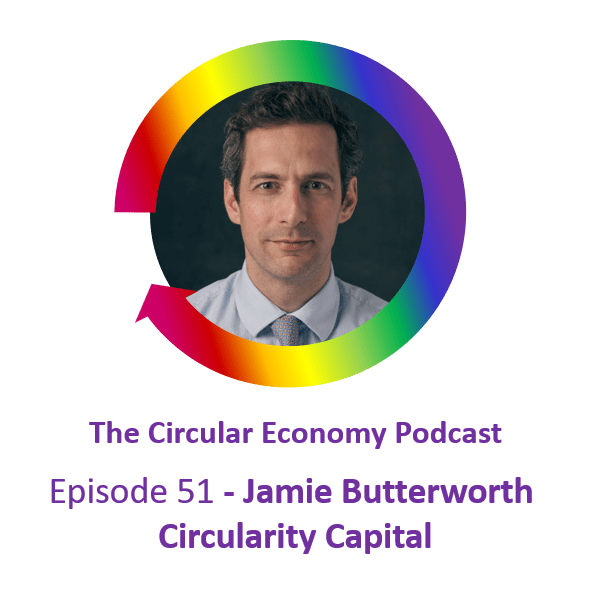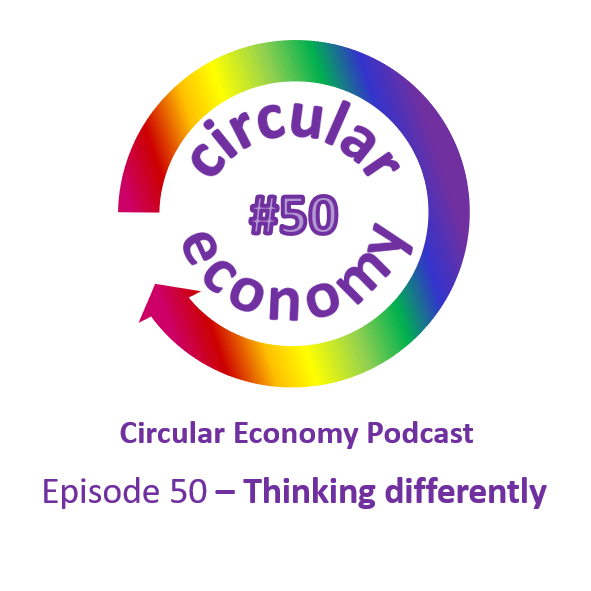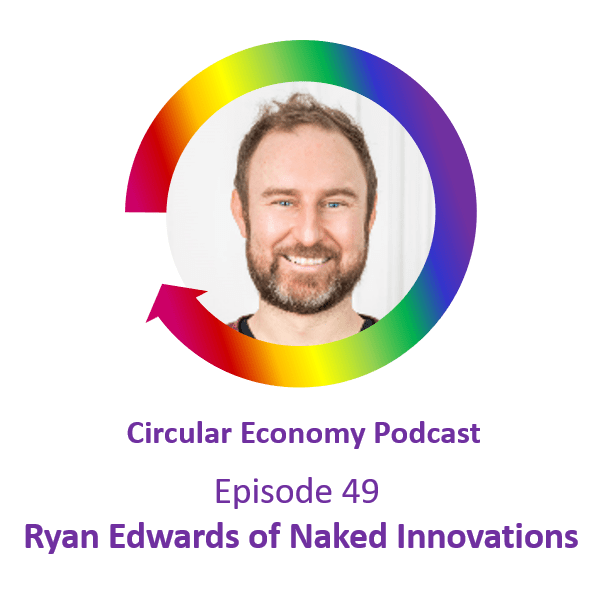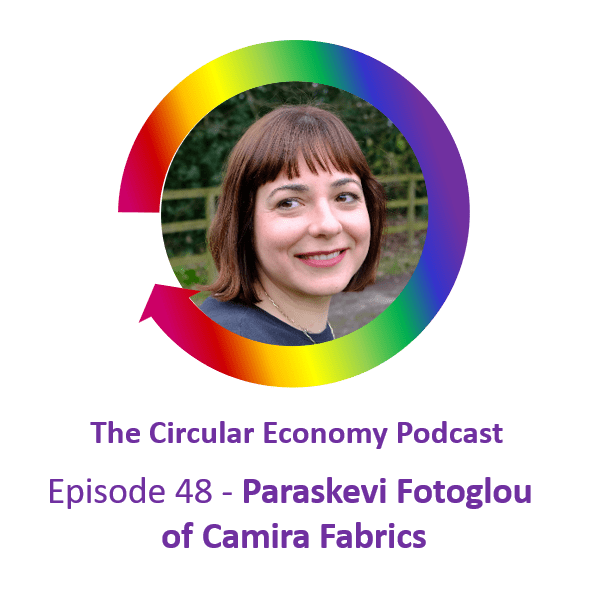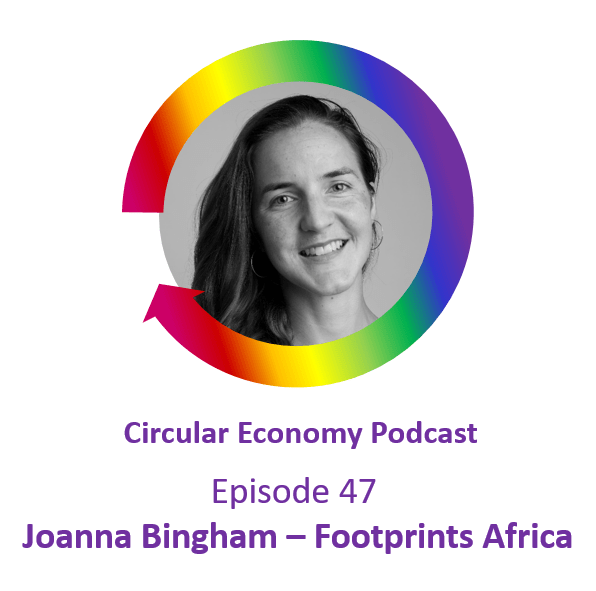Podcast: Play in new window | Download
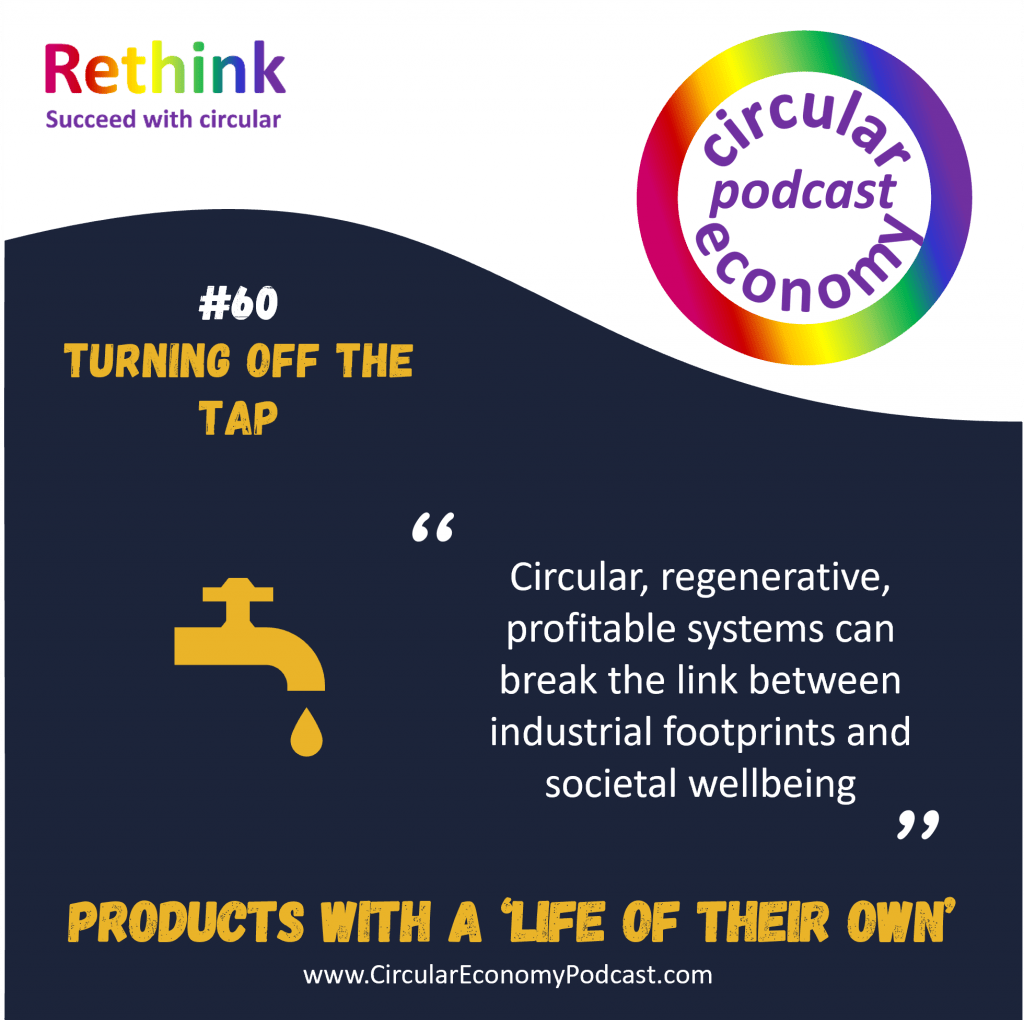
Every 10th episode, Catherine Weetman looks back at recent conversations and round up some of the insights we’ve heard:
The theme for this episode is turning off the tap. What do I mean by that? One of my favourite metaphors for the linear economy – our system of taking materials, making stuff, using it and then throwing it away. We’re pushing lots of resources in at one end of the pipe – but it gushes out at the end, and there are leaks all the way along the pipe with pollution going into the atmosphere, air, water and soil.
And all of that, of course, is undermining our ability to thrive on this planet.
So what can we do? We’ve got to radically rethink business as usual, to turn off that flow of resources and waste. We need to be regenerative instead of destructive and wasteful.
We need a different approach, so we have products with a ‘life of their own’*, not just serving a single user. We need objects designed for reuse and resale once someone no longer needs them, or objects available in multi user systems with customers sharing or renting when needed.
In this episode, we unpack the concept of ‘product for life’, to understand how it works, and why it helps to separate the benefits of products and services from their cost to the global commons, including examples from recent podcast guests.
*Thanks to Kresse Wesling of Elvis and Kresse (who talked about that), for giving me persmission to use her definition of a ‘Perfect Product’ in A Circular Economy Handbook.
Podcast host Catherine Weetman is a circular economy business advisor, workshop facilitator, speaker and writer. Her award-winning book: A Circular Economy Handbook: How to Build a More Resilient, Competitive and Sustainable Business includes lots of practical examples and tips on getting started. Catherine founded Rethink Global in 2013, to help businesses use circular, sustainable approaches to build a better business (and a better world).
Stay in touch for free insights and updates…
Don’t forget, you can subscribe to the podcast series on iTunes, Google Podcasts, PlayerFM, Spotify, TuneIn, or search for “circular economy” in your favourite podcast app. Stay in touch to get free insights and updates, direct to your inbox…
You can also use our interactive, searchable podcast index to find episodes by sector, by region or by circular strategy. Plus, there is now a regular Circular Economy Podcast newsletter, so you get the latest episode show notes and links delivered to your inbox on Sunday morning, each fortnight. The newsletter includes a link to the episode page on our website, with an audio player. You can subscribe by clicking this link to update your preferences.
Links we mention in the episode:
- A Circular Economy Handbook: How to Build a More Resilient, Competitive and Sustainable Business – buy from any good bookseller, or direct from the publisher Kogan Page, which ships worldwide (free shipping to UK and US) and you can use discount code CIRCL20 to get 20% off. It’s available in paperback, ebook and Kindle. If you buy it from online sources, make sure you choose the new edition with an orange cover!
- Sign up to get the podcast player and shownotes for each new episode emailed to your inbox
- Search for episodes by sector, circular economy strategy, person or organisation, using the interactive episode index on our website
- World Economic Forum – Circular Trailblazers paper https://www.weforum.org/whitepapers/circular-trailblazers-scale-ups-leading-the-way-towards-a-more-circular-economy
Interview Transcript
Provided by AI
Catherine Weetman 00:04
Hello, and welcome to the Circular Economy Podcast, where we find out how circular approaches are better for people, planet and profit. I’m Catherine Weetman, of Rethink Global. And I’ll be chatting with those people making the circular economy happen. rethinking how we design, make and use everything. We’ll talk to entrepreneurs and business owners, social enterprises and leading thinkers. You’ll find the show notes, links and transcripts at a circular economy podcast.com where you can subscribe to updates and our fortnightly edition of circular insights.
Catherine Weetman 00:50
Hello, and welcome to Episode 60 of the Circular Economy Podcast. It’s been a challenging time around much of the world. In the last couple of weeks, we’ve seen heat waves fires and floods across Europe, heat waves and fires in North America, and then an earthquake and hurricanes in Haiti. Plus, of course, all the upheaval in Afghanistan, my heart goes out to all those affected by these and other awful events. And of course, we’re all absorbing the sobering messages from the latest IPCC report on climate change, and wondering how we can each play our part in bending the curve on greenhouse gas emissions.
Catherine Weetman 01:35
In the last series, we’ve had great conversations with inspiring people in the United States, the UK, the Netherlands, Guernsey, Switzerland, and Cote d’Ivoire. And three of the organization’s circularity, capital, olio, and lush, have been on my guest wish list, right from when the circular economy podcast started. If you’re a regular listener, and if you’re not, I hope you will be, you’ll know this every 10th episode, I look back at recent conversations, and round up some of the insights we’ve heard. The theme for this episode is turning off the tap. What do I mean by that? When I’m giving presentations, I quite often use a photograph of a leaky hose pipe. And that’s one of my analogies for the linear economy. I describe our system of taking materials, making stuff, using it and then throwing it away as being like a leaky hose pipe. We’re pushing lots of resources in one end of the pipe, but it leaks out at the end. And all the way along the pipe with pollution going into the atmosphere, air, water, and soil. And all of that, of course, is undermining our ability to thrive on this planet. At the very least, it costs money to clean all of that up. But often it can be harmful to people, and harmful and destructive to the living systems we depend on for our survival.
Catherine Weetman 03:11
This week, I’ve been working on an article for a new online magazine. And I’ve been looking at how circular approaches can unlock business success in a world of challenges and constraints. And of course, those challenges and constraints include bending the curve on climate emissions, doing something positive about ecological destruction. So we’re starting to regenerate soil, water and living systems and dealing with the challenges of a finite world. Some resources are obviously finite, like metals, minerals, even fossil fuels, so we can get our head around the limits on those. But what we often forget is that land and water are finite. We’re certainly not making any more land and our modern systems of agriculture and our tendency to convert forests and savannas into farmland using fossil fertilisers and petrochemical based insecticides, pesticides and more. means we’re actually depleting the biology in those soils, depleting the nutrient contents. And of course, we’re clearing trees, hedges, ponds, and all sorts of other wildlife habitats. And as we know, more recently, that displacement of wildlife is what’s caused all the recent zoonotic diseases including Coronavirus. So now we’re threatening human health directly. It kind of feels like we’re heading towards a precipice. Our take make waste economy is driving the climate, ecological and health crisis we’re facing everywhere.
Catherine Weetman 04:47
So what can we do? We’ve got to radically rethink business as usual. We need to be regenerative instead of destructive and wasteful. And yet, the better our lifestyles, the bigger Our footprint grows with resource extraction, ecosystem degradation, waste and emissions. At the start of the series, and Episode 51, we spoke to Jamie Butterworth, of circularity capital. And Jamie explained why they see the future is all about circular businesses.
Jamie Butterworth, Circularity Capital 05:22
First and foremost, many circular business models, if deployed correctly, will create more value than linear economy business models, because we’re able to improve margin for example, by using products more than once improve asset utilisation and also cascade things for a second use life’s
Catherine Weetman 05:45
and what do you think about the compliance and regulation appetite for greener taxes and more carrot and stick around? Say, taxing the use of virgin resources, taxing waste and pollution more heavily to kind of move towards extended producer responsibility? Are you getting any signals that investors would like that to level the playing field more in favour of more sustainable businesses? Are you getting the feeling that governments are moving towards that?
Jamie Butterworth, Circularity Capital 06:14
So I think a couple of things. So why is this the main focus at the moment in financial markets focuses on kind of compliance around ESG. And also more transparency around what’s being reported, in particular, for example, greenhouse gas emissions, there’s more and more interest as well about biodiversity with a view that just looking at carbon is too simplistic. And ultimately, all of the value creation activities that we use today have an impact on biodiversity as well. So kind of an example of the complexity of what companies are looking to report so that that is being driven mainly, I would say, by kind of compliance, and also reporting side, I think quite separately as the debate around the pricing of externalities into the system. So for example, the price of carbon. And I think there is a growing awareness that there are these environmental externalities, whether it’s clean water or clean air, etc, which currently aren’t factored into the system. I think that the debate around that is probably most advanced in Europe, then North America and then rest of world. But I think it’s still quite a long way away from being in kind of general consciousness. And something that will be acted on will be at the carbon price obviously, is more advanced than the rest.
Catherine Weetman 07:42
Over the last 50 years, global resource use has tripled, and it’s growing 70% faster than population. The extraction and processing of materials, fuels and food causes over half of greenhouse gas emissions. And it’s responsible for 90% of water stress and biodiversity loss. We’ve caused climate chaos with depleted oceans, we’ve created water scarcity. And we’ve degraded land everywhere and humanity’s causing widespread extinction of other species. So how did we get to this cliff edge? I think it’s with our relentless drive for business growth, more sales, faster fashions, single use and disposability, underpinned with the myth of consumerism, that more stuff makes us happy. Of course, population growth and other developments in the last century. For instance, better sanitation, better healthcare, industrialised agriculture, and so on, have all helped fuel this, but at the heart of it is the drive for business growth.
Catherine Weetman 08:51
Being bigger is seen as a badge of success for business. Most companies depend on increasing consumption, increasing sales, and often that’s being enabled by ever more sophisticated marketing strategies. behavioural psychology and other techniques hook customers into buying more and replacing things more quickly. Happiness chemicals, including dopamine, the reward molecule, and oxytocin, the love hormone, can drive sales and addictive behaviour. We’re all guilty of willful blindness, we buy more and better things to fuel our highest standards of living. Yet this degrades humanity’s wealth, our global commons, undermining the well being of future generations. Now though, leading thinkers, NGOs, politicians, and even major consultancies are highlighting the conflict between business success and social prosperity.
Catherine Weetman 09:53
So how do we rethink these systems to live within the limits of our planet? How can companies find ways to supply Are those desirable functional objects to meet our aspirations for higher living standards without increasing the carbon, ecological and resource footprint? What behavioural shifts can marketers encourage? Each successive industrial revolution has used breakthroughs in power generation, communications and transport to spark innovation and build new industries. And of course, to expand our footprint. The next industrial revolution will be different based on circular, caretaker, mindsets, and systems thinking. To help conserve and regenerate precious resources and ecosystems, it’s going to be a circular revolution.
Catherine Weetman 10:48
Circular approaches hold the key to the puzzle. Circular systems change the dynamic, breaking the link between consumption and wellbeing. It means we can see success through a different lens, you’ve probably come across different definitions of the circular economy, with most schools of thought using these four principles, number one, designed to keep products or materials in use. Number two, eliminate waste and pollution. Three, recover and regenerate resources and living systems. And number four, use safe sustainable materials. What I’m noticing is that businesses, especially big global companies, are leaning towards increasing recycled content, improving recyclability, and developing new generation materials. But these advances don’t tackle the main issue our vast consumption, we need a break through products that have a life of their own. Instead of just serving a single user. We need objects designed for reuse and resale once someone no longer needs them, or objects available in multi user systems with customers sharing or renting when needed. Let’s unpack this to understand how it helps to separate the benefits of products or services from their cost to the global commons.
Catherine Weetman 12:18
First, we can design things to be durable and robust, easy to care for to repair an upgrade, so we can keep them in use for much longer. Circular designs allow products to be efficiently remade, remanufactured including rigorous testing and replacement of worn components. remanufacturing means cheaper, high quality high performance products backed by a solid warranty. You might be thinking more expensive products would be less affordable. But no, extra costs are more than offset by a reduced cost of ownership. over a longer lifetime. The purchase cost plus maintenance minus resale value is lower for each customer in the in the ownership chain. The result is better value. Patagonia, Fairphone and Vitsoe all embed these approaches into their business models.
Catherine Weetman 13:18
And we know how to do this. It’s how we made things just a few decades ago. Cars, household appliances, furniture, clothes, shoes, and technology. Were all designed to last several decades, not just a few years. homie in the Netherlands provides paper use home appliances, rewarding customers for using lower impact wash cycles. After just a few weeks, customers were washing 30% less and using less energy and water than they were beforehand. Have a listen back to Episode 17, to hear from Nancy Bocken, co founder of Homie, and one of the leading academics working on the circular economy. In Episode 56, we met Laura Meijering, who set out to unravel all the things that are wrong with fast fashion through her business, Unravelau in the Netherlands, which provides “atelier” (sewing and design) services and also helps educate young people about the wider aspects of sustainability.
Laura Meijering 14:25
Yeah, so at Unravelau, we don’t produce more than one collection a year. And actually, right now at this moment, we don’t produce any collections, but we just only produce whenever a client gives us an assignment. And what do you think is important about that is because even if you only make one collection a year, there’s still some pieces in there that people might not want. Which is a shame. It’s a shame of my time as an artist that I put in there but also it’s a shame of other sources I’ve wasted with that. So now what we do, we go in, we have contact with the clients, and then they come to us. And they say, Well, I would like to have a suit for this occasion, for instance. And based on a conversation with them, we get to know them better. And we can decide like, Okay, this is the kind of style that maybe suits you, and kind of fabric that would fit with it, then we’re presented to them. And if they like to sketch if they like the idea that we continue with it, and we start making a prototype, and we do a fitting with them, and along the way, each time, the client can still say, Okay, I want this to be changed, I would use a bit more to my taste. I think this is a bit too raw, I think this is too wide. I think this is too tight. Can I change it a bit, and we’re just completely open to it, it will still in the end, it will still be an Unravelau suit for the client. But by just listening to them very carefully, we can make sure that we actually make something for them that they want and that they will wear for a very long time.
Catherine Weetman 15:59
What about business impact, selling fewer new high quality products supports healthy profit margins in the longer term. Some overheads are lower, with fewer new product launches and less marketing to find new customers, or to encourage people to upgrade their existing products. Plus the revenue opportunities from selling servicing spare parts and upgrades, and from supplying resale subscription and paper use services. Secondly, we can design objects to be used more intensively rented shared or exchanged with other users. That means we get more use from the product and its embedded resources. Algramo and Loop offer reusable packaging that’s more convenient and better value. So brands like Unilever and Nestle can engage directly with consumers. You can find out more about Algramo in Episode 42. Another example is Grover in Germany, one of circularity capitals investments. Grover rents out the latest technology products with affordable and flexible options. Grover’s customers rent products like phones, laptops, entertainment, equipment, sports, tech, and so on. It means people can use something when they need it and send it back when they don’t. circularity capital likes rental systems because they maximise usage and minimise waste. Finally, we need to recover value instead of wasting it. Once the product eventually reaches the end of its life, circular systems recover products and regenerate the materials we need for the next generation of products. by designing circular products to have a life of their own, we can decouple industries footprint from the value delivered to society. We reduce resource and environmental cost by extending lifetimes to slow the replacement cycle, or by supplying the same level of service through fewer products to boost productivity. In other words, we’re pushing less liquid through that leaky hose pipe. And that means less waste coming out of all those leakage points all along the process.
Catherine Weetman 18:19
This is radical, it’s not resource efficiency or making a few tweaks to product design. It’ll be as disruptive as digital, changing every aspect of business from finance, sales, marketing and operations to your entire supply chain. by bending the curve, turning off the tap on accelerating levels of waste emissions and resource use, we can start to regenerate depleted soils, forests, rivers and oceans. Let’s go back to that image of the leaky hose pipe pumping through evermore resources and pouring waste and pollution out all along the pipeline, as well as at the end of the pipe. The question is how do we slow the flow through the pipe and all its leaky holes. It’s only by turning off the tap that we’re going to reduce the size and impact of our footprint. just swapping from finite materials to renewable materials doesn’t solve the problem. In fact, it may make things worse, causing more deforestation and ecosystem destruction.
Catherine Weetman 19:25
The obvious thing we can do is to be more frugal. And that’s transformational and makes a big impact. But most of us don’t want to do that. And telling people that they need to have less doesn’t seem like a strategy for success. It’s not painting a picture of an exciting future that we can all embrace. Instead, we need to change mindsets. change how we think about what we buy, so that people see having access to useful products and services is more convenient and better for all of us than having Wanting to own it and have exclusive use of it. And what’s encouraging is that the younger generation is really buying into this Generation. Zed doesn’t necessarily want to be tied down by owning products, cars, technology, houses, and even clothing. As soon as items that you can easily rent when you need them, and send them back when you don’t. This is where the circular economy helps break the link between our footprints, and the push for better standards of living. Those longer lasting products might have several owners over their lifetime.
Unravelau and Lush are companies developing products and packaging that last longer can have several use cycles, and builds emotional engagement with the user. Techbuyer and OLIO are circular service providers helping recover products that still have value and get them back into the system so they can be used again.
Catherine Weetman 20:59
In Episode 53, Techbuyer’s Managing Director, Mick Payne, explained how they remanufacture it storage and servers to provide high quality, reliable and high performance equipment. That’s often both better value and better from an energy usage and efficiency point of view. Compared to the new equivalent, Techbuyer provide added value services, helping their customers understand what the optimum specification is to meet their needs. So companies aren’t buying more storage than they need, or buy more performance or using more energy than they need to.
Catherine Weetman 21:40
In Episode 58, Elis Joudalova explained how OLIO helps food get used before it goes out of date. It’s a really convenient way for people to actually exchange food with their neighbours, or for retailers to dispose of food nearing the end of its life before it ends up being wasted. And we heard from Rae Stanton of Lush in Episode 57, about permaculture thinking and some of their packaging innovations. Lush has pioneered what it calls ‘naked’ packaging, which it uses for solid products that don’t need containing. Lush has come up with other innovations like cork pots. Cork is a renewable material from the bark of a species of oak tree. The bark re grows over a few years after it’s been harvested. The trees not cut down when the barks removed and so caught can be farmed regeneratively. When I interviewed Rae, she was wearing an attractive headscarf that had been a wrap for a Lush cosmetic product. So the packaging itself could be repurposed as clothing or used to wrap something else and so on.
Catherine Weetman 22:50
Let’s go back to our second strategy to get things used more intensively. The aim is to set up systems to help us get more use out of objects, so we need less of them in the economy. An example I often use here is thinking about car sharing. In Europe, the average car is in use for less than two hours every day, and probably a lot less during lockdown. So if instead we had cars in a car share system or a paper use system, we could easily imagine those same cars being rented out for 812 or even more hours every day. That means we get a lot more productivity from the car. It’s about getting more use from the car and its components and materials. And that means we need less cars overall in the system. Again, that slowing down the flow of materials going through our metaphorical hose pipe.
Catherine Weetman 23:47
And Episode 55 we spoke to Anthony Burns of ACS about how ACS helps companies that are offering rentals subscriptions and resale. Doing all the processing and back office work to recover those products, get them cleaned, make any repairs and get them back out to the next customer. ACS also offers recommerce services. And that means dealing with returns from customers who’ve ordered clothes online. ACS check everything that comes back, making sure it goes back into stock if it’s suitable, gets cleaned if necessary, or is identified as needing to go into another sale stream. In Episode 54, we met Louise Bijleveld from LONO in Cote d’Ivoire. LONO is another specialist circular service provider helping get more value out of agricultural waste. LONO works with farmers and food producers looks at the kind of waste they end up with on the farm, which in Cote d’Ivoire, maybe cocoa bean pods, one oh looks for compatible sources of biological waste that can make good quality compost bio energy. In previous series we talked to Tamsin Chislett at Onloan in Episode 44. And Eve Kekeh at Bundlee in Episode 18, about their rental and subscription services for fashion and baby clothes respectively. And we’ve heard how much customers love subscription services. People want to be more sustainable, people don’t want to be wasting clothes after only a few wears, they feel much better being able to use high quality, well made beautiful clothing for as long as they need it, and then send it back to be used by someone else. After Of course, it’s been cleaned and cared for by Bundlee and Onloan.
Catherine Weetman 25:44
So those are two strategies to help products have a life of their own. Either longer lasting products, or products that can be used more intensively, shared, rented and so on. After both of those, we need to recover the products and the materials to get them back into the system. That way we close the loop on all those wasted materials. We need to focus on designing products. So we have to do less than to get them back into the system, the less we do the better. If we just focus on recycling, it means we’re using an awful lot of energy to get very little value out of the product. We may even need to use lots of chemicals to convert the materials back into something we can use. So really, that’s all going back through the same leaky hose pipe again, we’re not significantly slowing down the flow. And we’re probably not bending the curve on greenhouse gas emissions.
Catherine Weetman 26:45
In Episode 57, we heard from Helen Burdett at the World Economic Forum about some of the brilliant work they’re doing on the circular economy. We talked about Circular Trailblazers, these are scale up businesses with a purpose beyond profit. So they make a social impact – they’re seen as being able to disrupt entire industries sectors with their new circular propositions. The World Economic Forum has produced a report analysing what makes a trailblazer and how they’re different to other startups and scaleups. And I’d recommend that short report. I’ll put a link again in the show notes. The World Economic Forum’s circular trailblazers include Excess Materials Exchange, (we spoke to Christian van Maaren in Episode 32(, Algramo (and we heard from Brian Bauer in Episode 42) and Fairphone. Helen, explains the challenges of what she called linear lock-in.
Helen Burdett 27:47
Yeah, we think of that sometimes as the linear lock in – that it is harder to operate outside of this system that we’ve optimised for the past 200 years that is linear, that some of the tactics that we think about for trailblazers taking on and these are kind of identified as the top five and the report around storytelling for impact. So how to get out there and tell a story that is not only valuable for your business as a impact scale up, but also can unlock the market for others, and have unlocked hearts and minds to be thinking in a more circular way. And others setting that higher standard. So you mentioned that kind of raising the bar that continues to come up sharing insights, not being so competitive that you refuse to share anything that might help others become more circular. Yes, you need to be competitive as a as a for profit business. And we aren’t saying that to be an impact scale up or a Circular Trailblazer you need to put your business second. These are all tactics that should be undertaken, while putting your business first, initiating that collaboration and then influencing public policy. So it may be changing policies so that your business can be successful, but that also enables other businesses to take on similar models.
Catherine Weetman 29:08
Let’s go back to Episode 51. with Jamie Butterworth, of Circularity Capital. Jamie explained why Circularity Capital focuses on investing in those inner loops of the circular economy, reuse, repair and reducing waste. It’s investing in companies like Grover, Winnow and Zig Zag. And like the World Economic Forum there try to identify businesses that can scale up and make a big difference. Either disrupting a sector or creating value from a difficult to use material. Jamie gave the example of Shark windscreens which is managing to recycled laminated windscreens. that’s highly complex because of the different layers of materials.
Catherine Weetman 29:52
Yet it also creates a high value recycled material to keep objects in use for long good Rrepair is critical. Repair Cafes are springing up all around the world. And these are free to use community initiatives that help people with repairing all sorts of things, from Tech to furniture, to clothing to treasured objects. In Episode 52, we heard some amazing stories from Elizabeth Knight, co author of a brilliant book called Repair Revolution. Elizabeth is a brilliant storyteller and told us about all sorts of ways that people engage with repairs, and what a difference those repair cafes can make to a community. Breaking down social barriers, bringing people together, helping people share skills, building confidence, and so on. Repair cafes exist all around the world, you might be able to find one near you and get involved in helping extend the life of your stuff. Being a caretaker, instead of discarding things. #caringiscool! Turning off the tap, slowing the flow of materials and all that associated waste and shrinking our massive footprint of emissions, ecological damage, and overuse of resources land and water is a massive challenge. But we know how to do this. It’s not rocket science. It just needs different mindsets focused on creating value, and regenerating our global commons. I believe the circular economy is a critical tool to create future fit prosperous businesses, caretaking companies that contribute to societies and create value for future generations. We’re already in the decisive decade. It’s time to rethink your strategy for a circular revolution.
Want to dig deeper?
Why not buy Catherine’s award-winning book, A Circular Economy Handbook: How to Build a More Resilient, Competitive and Sustainable Business. This comprehensive guide uses a bottom-up, practical approach, and includes hundreds of real examples from around the world, to help you really ‘get’ the circular economy. Even better, you’ll be inspired with ideas to make your own business more competitive, resilient and sustainable.
Please let us know what you think of the podcast – and we’d love it if you could leave us a review on iTunes, or wherever you find your podcasts. Or send us an email…
Podcast music
Thanks to Belinda O’Hooley and Heidi Tidow, otherwise known as the brilliant, inventive and generous folk duo, O’Hooley & Tidow for allowing me to use the instrumentals from the live version of Summat’s Brewin’ as music for the podcast. You can find the whole track (inspired by the Copper Family song “Oh Good Ale”) on their album, also called Summat’s Brewin’. Or, follow them on Twitter.
